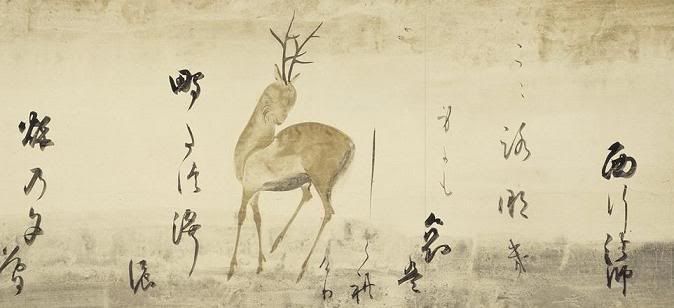Website for this image: Poem Scroll with a Deer |
by aleks
'LUMINOUS • The Art of Asia' exhibition at Seattle Art Museum will be displayed till January 8th, 2012 - make sure you see it, as it is quite extraordinary. It showcases the jewels of SAM’s Asian collections, from Chinese bronzes and Japanese lacquers to Korean ceramics and South Asian sculpture and painting; but the collection itself is not what drew me in: how many more vases, scrolls and kimonos one can see in a lifetime - it is the way it is presented which makes it all very special.
This particular exhibit is all about context - something usually very missing in museums and easily making me leave the place when I'm sufficiently dazzled and overwhelmed, but not necessarily wiser.
Artist Do Ho Suh, who put it together, was exceptionally mindful about that very aspect - seeing his way of arranging material is a super-satisfying experience and easily incorporated into what one already knows: by learning how objects circled the globe, lost and gained value depending on surroundings, their original meaning (usually sacral) as opposed to current meaning (esthetic).
I was particularly touched by a story and exhibit of 'Poem Scroll with a deer' - it turns out that SAM owned the second half of a 72' scroll like forever, but it wasn't until last year's scroll's visit to japan, that it was reunited with the first half, that was in pieces and dispersed among public and private collections there! here is the scroll and the story:
Website for this image: The literature Network Forums |
I like to visit exhibitions twice: once with a guide and once by myself (not necessarily in that order) - this one I'd like to visit many, many times.
Here is more info on the exhibition:
Luminous: The Art of Asia
October 13, 2011–January 8, 2012
SAM Simonyi Special Exhibition Galleries
Hours:
Wednesday–Sunday: 10 am–5 pm
Thursday & Friday: 10 am–9 pm
Monday & Tuesday: closed
Free Days:
All free day programs include access to special exhibitions as well as all SAM collections and installations. Exceptions may apply to special exhibits that carry a surcharge.
First Thursdays: Free to all
First Friday: Free to seniors (age 62+)
Second Fridays, 5–9 pm: Free to teens (ages 13–19) with ID




